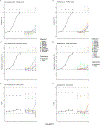In vitro endocrine and cardiometabolic toxicity associated with artificial turf materials
- PMID: 39245243
- PMCID: PMC11499011
- DOI: 10.1016/j.etap.2024.104562
In vitro endocrine and cardiometabolic toxicity associated with artificial turf materials
Abstract
Artificial turf, a consumer product growing in usage in the United States, contains diverse chemicals, some of which are endocrine disruptive. Endocrine effects from turf material extracts have been primarily limited to one component, crumb rubber, of these multi-material products. We present in vitro bioactivities from non-weathered and weathered turf sample extracts, including multiple turf components. All weathered samples were collected from real-world turf fields. Non-weathered versus weathered differentially affected the androgen (AR), estrogen (ER), glucocorticoid (GR), and thyroid receptors (TR) in reporter bioassays. While weathered extracts more efficaciously activated peroxisome proliferator activated receptor γ (PPARγ), this did not translate to greater in vitro adipogenic potential. All turf extracts activated the aryl hydrocarbon receptor (AhR). High AhR-efficacy extracts induced modest rat cardiomyoblast toxicity in an AhR-dependent manner. Our data demonstrate potential endocrine and cardiometabolic effects from artificial turf material extracts, warranting further investigation into potential exposures and human health effects.
Keywords: Adipogenesis; Cardiotoxicity; Endocrine disruption; Leachate; Nuclear receptor; Synthetic turf.
Copyright © 2024 The Authors. Published by Elsevier B.V. All rights reserved.
Conflict of interest statement
Declaration of Competing Interest The authors declare the following financial interests/personal relationships which may be considered as potential competing interests: Christopher Kassotis reports financial support was provided by National Institute of Environmental Health. Christopher Kassotis reports financial support was provided by Wayne State University. If there are other authors, they declare that they have no known competing financial interests or personal relationships that could have appeared to influence the work reported in this paper.
Figures







References
-
- Armada D, Llompart M, Celeiro M, Garcia-Castro P, Ratola N, Dagnac T, and de Boer J 2022. Global evaluation of the chemical hazard of recycled tire crumb rubber employed on worldwide synthetic turf football pitches. Science of The Total Environment. 812:152542. 10.1016/j.scitotenv.2021.152542 - DOI - PubMed
-
- Armada D, Martinez-Fernandez A, Celeiro M, Dagnac T, Llompart M 2023. Assessment of the bioaccessibility of PAHs and other hazardous compounds present in recycled tire rubber employed in synthetic football fields. Science of the Total Environment. 857 part 2:159485. 10.1016/j.scitotenv.2022.159485 - DOI - PubMed
-
- Arp HPH, Kühnel D, Rummel C, MacLeod M, Potthoff A, Reichelt S, Rojo-Nieto E, Schmitt, Jansen M, Sonnenberg J, Toorman E, and Jahnke A 2021. Weathering Plastics as a Planetary Boundary Threat: Exposure, Fate, and Hazards. Environmental Science & Technology. 55(11):7246–7255. 10.1021/acs.est.1c01512 - DOI - PubMed
MeSH terms
Substances
Grants and funding
LinkOut - more resources
Full Text Sources
Research Materials

